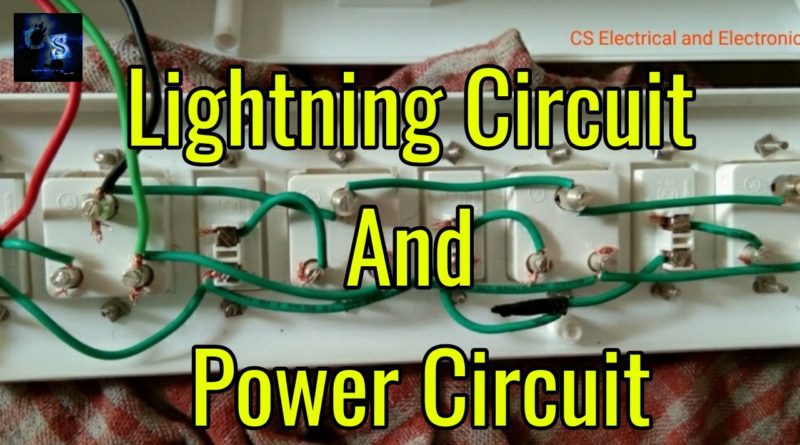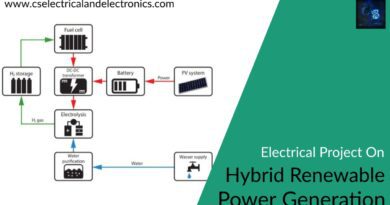Lighting Installation Code of Practice, Lightning Circuit, And Power Circuit
Hello everyone, in this article I will discuss the lighting installation code of practice, the difference between lightning circuit and power circuit.
Code of Practice means nothing but basic knowledge for house wiring. If you want to become an electrician in the future these points are important for you all.
Before starting the article if you want to watch a video related to electrical estimation and costing, you can watch my YouTube videos – Click Here.
Also read – Electrical Switchgear And Protection Questions And Answers.
Lighting Installation
01. One lighting circuit the maximum load that can be connected is 800 watts or the maximum number of points that can be wired is 20. See guys in one switchboard you can give a load of 800 watts, give any load like fan, light, TV, etc but the sum of all the load wattage should be less than 800 watts.
02. Every circuit should be provided with a separate cut-out in the distribution board for their line ( phase or positive) wire. Every circuit should have fuse or M for safety purposes, if any fault occurs in a circuit the circuit must trip.
03. Switches must be placed inline wires only – The control for light or fan is done by operating switches, so every and each switch must always be connected in series with the phase wire.
04. An adequate number of socket outlets are to be provided at suitable places in all rooms – All switchboards should be provided with the socket so that consumers can connected additional load like phone charging and other appliances.
05. A switchboard is to be installed so that its bottom lies 1.5m above the floor – The height of the switchboard from the ground level should be a minimum of 1.5 meters so that it will be easy to turn on or off the switches and it is also safe for children.
06. All plugs and socket-outlets are to be 3-pin type – Every switchboard should contain a three-pin socket and avoid using a two-pin socket because they don’t have an earth pin and it will not be safe.
07. All fixtures like lamps and ceiling fans are to be hung 2.5m above the floor – Minimum clearance for lamps and fans should be 2.5 meters from the ground level.
08. Ironclad switches appropriate pin of 3-pin socket should be properly earthed.
09. The power or AEH circuit must be drawn separately in AEH, installation from the mainboard – The circuit for power socket should be different and the circuit for lightning should be different.
10. Earth Leakage Circuit Breaker is used for loads above 5 KVA – ELCB is also a protective device, ELCB is a protective device for human beings because when we touch any phase wire, immediately earth leakage circuit breaker will trip whereas in case of miniature circuit breaker it will not trip. MCB trip only during short circuit and overload conditions occur whereas ELCB trips in three conditions while short circuit, overload, and if a person touches any live wire.
11. Lighting circuit and AEH circuit should have separate earthing – The earthing system for lightning circuit and power circuit should be provided separately.
12. The conductor used is to be of such a size that it may carry load current safely – Always first calculate the load current and then select the proper size of the wire using the wire table.
13. Every installation is to be properly protected near the point of entry of supply. For 1-phase cables by a two-pole linked main switch and a fuse unit, 3-pole switch and fuse unit are to be used in 3-phase supply.
14. When a total load of lighting exceeds 8 KVA, then three-phase supply is to be used and load should be equally distributed to all phases.
15. No socket-outlet is to be provided in the bathroom at a height less than 1.3 meters and where there are chances of entering the water. There is also a chance of shock, so careful of it.
Different loads of various appliances
- 01. The wattage of the ceiling fan is 80 watts.
- 02. The wattage of Tubelight is 40 watts.
- 03. The wattage of the Incandescent lamp is 60 watts.
- 04. The wattage of Heater is 500 to 2000 watts.
- 05. The wattage of washing machines is 1500 watts.
- 06. The wattage of TV is 300 watts.
- 07. The wattage of the refrigerator is 240 to 600 watts.
- 08. The wattage of iron is 1200 watts.
- 09. The wattage of soldering iron is 200 watts.
- 10. The wattage of the vacuum cleaner is 1360 watts.
- 11. The wattage of the laptop is 130 watts.
- 12. The wattage of an LCD monitor is 110 watts.
- 13. The wattage of the microwave is 1710 watts.
- 14. The wattage of the hairdryer is 120 watts.
Difference Between Lightning Circuit And Power Circuit
Power circuit and lighting circuit both are the points where we will get Electricity but the use of power circuits and lighting circuits is different.
The power circuit is used where heavy loads are present. The loads which consume more power are connected to Power Circuit. The loads which consume more power are AC, washing machine, heaters, etc. these are the loads that consume more power.
The wires used in the power circuit have different size as compared to the lighting circuit. The size of the wire used in the power circuit is 2.5 sq mm and the rating of socket outlets and switches is 15 A, 230 V.
The loads which consume less power are connected to Lighting Circuit. The loads which consume less power are fans, LED lights, CFL, etc these are the loads that consume less power.
The size of the wire used for lighting circuit is 1 sq mm or 1.5 sq mm and the ratings of socket and switches are 5 A, 230V.
Tags: Lighting Installation Code of Practice, Difference Between Lightning Circuit And Power Circuit.
Also, read:
- 10 Tips To Maintain Battery For Long Life, Battery Maintainance
- 10 Tips To Save Electricity Bills, Save Money By Saving Electricity
- 100 (AI) Artificial Intelligence Applications In The Automotive Industry
- 100 + Electrical Engineering Projects For Students, Engineers
- 1000+ Control System Quiz, Top MCQ On Control System
- 1000+ Electrical Machines Quiz, Top MCQs On Electrical Machines
- 1000+ MATLAB Simulink Projects For MTech, Engineering Students
- 50 Tips To Save Electricity At Home, Shop, Industry, Office
- 50+ Question And Answer On The Substation, Electrical Question
- 500+ Matlab Simulink Projects Ideas For Engineers, MTech, Diploma
- 500+ Projects For Diploma Electrical, Electronics Student, Diploma Project
- Active Cell Balancing Using A Flyback Converter Simulation In Matlab Simulink
- AI Artificial Intelligence Applications In Electric Vehicles | Future?
- AI Tools For Electronic Circuit Design, Which Is Best?
- Applications Of Artificial Intelligence (AI) In Renewable Energy
- Automotive Industry Or VLSI Chip Industry ? Which Is Best?
- Basic Electrical Engineering, Terms, Definitions, SI Unit, Formula
- Basic Electrical Quiz, Take Online Test On Basic Electrical, Electrical Quiz
- Battery C Rate Online Calculator With Time Calculation
- Battery Management Systems In Electric Vehicles, BMS Operations
Author Profile
- Chetu
- Interest's ~ Engineering | Entrepreneurship | Politics | History | Travelling | Content Writing | Technology | Cooking
Latest entries
 All PostsApril 19, 2024What Is Vector CANoe Tool, Why It Is Used In The Automotive Industry
All PostsApril 19, 2024What Is Vector CANoe Tool, Why It Is Used In The Automotive Industry All PostsApril 13, 2024What Is TCM, Transmission Control Module, Working, Purpose,
All PostsApril 13, 2024What Is TCM, Transmission Control Module, Working, Purpose, All PostsApril 12, 2024Top 100 HiL hardware in loop Interview Questions With Answers For Engineers
All PostsApril 12, 2024Top 100 HiL hardware in loop Interview Questions With Answers For Engineers All PostsMarch 22, 2024Driver Monitoring Systems In Vehicles, Working, Driver Sleepy Alert
All PostsMarch 22, 2024Driver Monitoring Systems In Vehicles, Working, Driver Sleepy Alert








